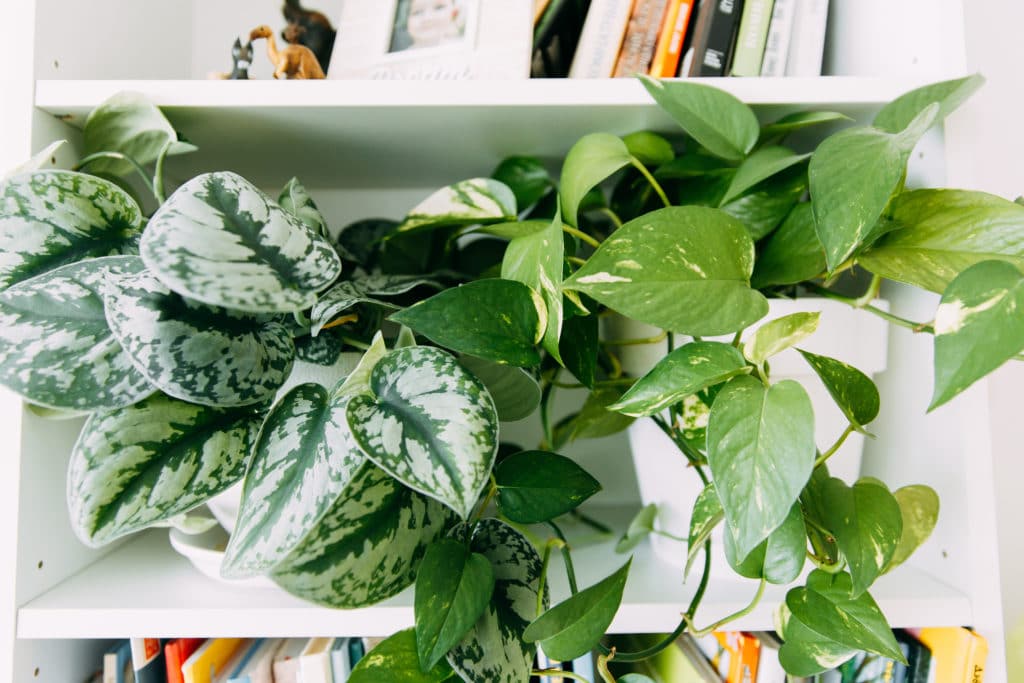
When it comes to Scindapsus plant varieties, there are few questions that come up more often than “how do I take care of Scindapsus?”
The truth is that Scindapsus care isn’t all that complicated. But if you want the best Scindapsus plants in your home or office, you need to know what to do.
Today we will go over some top tips for caring for Scindapsus varieties so you can have beautiful pothos plants at work and home.
Scindapsus Varieties Backstory
Scindapsus is a genus of flowering plants in the Araceae family.
They are blooming plants, but they don’t usually bloom indoors like many houseplants. They are vines, and they love to climb. They’ll grow happily up a pole or trellis in your home or office space.
There are many Scindapsus varieties to choose from. Some of the most common include Scindapsus aureus (golden pothos), scindapsus pictus (silver pothos), and Scindapsus officinalis (Asian swamp vine).
But there are also some rarer scindapsus varieties out there that you may not have heard of before.
One such variety is Scindapsus argenteostriatus, which has beautiful silver leaves with black stripes on them.
Another is Scindapsus marmoratus, which has lovely green leaves with marbled patterns on them.
And Scindapsus japonicus has big green leaves with white spots that are really striking!
Scindapsus Care Tips
The first Scindapsus care tip is to give your plant lots of indirect sunlight, but not direct sun.
A good rule of thumb for Scindapsus plants and most other houseplants is: the brighter the better!
Bright light will keep Scindapsus strong and healthy, so be sure it gets as much as you can provide indoors (though don’t place it in a window where it’ll get full afternoon sun).
If possible, try to position your Scindapsus plant outside on nice days, or else set up grow lights overtop if they’re inside all the time.
Watering
Water Scindapsus plants regularly, but be careful not to overwater them. Overwatering is one of the most common Scindapsus care mistakes people make.
So how do you know when your plant needs water? The best way is to feel the soil with your fingers. If it feels dry, then give it a good watering.
Another Scindapsus care tip: don’t let the pot sit in water or allow the roots to stand in water either. This can cause root rot and other problems for your Scindapsus plant.
Fertilizer
Fertilize Scindapsus plants every month or so with a balanced liquid houseplant fertilizer (20-20-20). And if you’re growing Scindapsus in soil that’s low in nitrogen, you may need to supplement with a high-nitrogen fertilizer once in a while.
Pruning
Pruning Scindapsus is optional, but if you do it make sure to use clean scissors or clippers and disinfect them between cuts.
Snip off any dead or dying leaves as well as any stems that are too long or growing in the wrong direction. This will help keep your Scindapsus plant looking neat and tidy.
As you can see, caring for Scindapsus plants is not difficult at all! Just follow these simple tips and your Scindapsuses will be thriving in no time!
Scindapsus Varieties Care: Top 11 Scindapsus Plants
There are many different Scindapsus varieties to choose from ranging from relatively common to extremely rare. Here are some top selections!
– The first scindapsus plant on our list is Scindapsus pictus.
This is one of the most common Scindapsus varieties and it’s also one of the easiest to take care of. S. pictus needs medium light levels and doesn’t require much fertilizer. Water regularly, making sure to let the soil dry out between waterings
– Next up is Scindapsus aureus ‘Argenteus’ which has bright yellow leaves with green veins. This Scindapsus variety prefers high light levels but can adapt to lower levels if needed. Fertilize regularly with a balanced fertilizer and water frequently
– Next is the Scindapsus aureus ‘Marble Queen’ which has beautiful white leaves with green veins. This Scindapsus variety also prefers high light levels but can adapt to lower levels if needed. Water regularly, making sure to let the soil dry out between waterings
– The Scindapsus pictus ‘Albomaculatus’ is a Scindapsus plant that has white leaves with black spots. This scindapsus variety needs medium indirect light levels and doesn’t require much fertilizer. Water regularly, making sure to let the soil dry out between waterings
– The Scindapsus aureus ‘Silver Satin’ Scindapsus plant is next. This Scindapsus variety has yellow-green leaves with green veins. It prefers bright indirect light levels but can adapt to lower levels if needed. Fertilize regularly with a balanced fertilizer and water frequently
Next up is the Scindapsus goei which has dark green leaves that are almost black. this Scindapsus variety needs medium light levels and doesn’t require much fertilizer either! Water regularly, making sure to let the soil dry out between waterings
The Scindapsus plant known as Scindapous nainitalensis should be next on our list of Scindaspsus plants! This Scindapsus plant has light green leaves with dark marbling. This variety prefers high light levels but can adapt to lower levels if needed too! Water regularly, making sure to let the soil dry out between waterings
The Scindapsus ‘Golden Pothos’ is next on our list of Scindapsus plants! This pothos variety has yellow-green leaves that are variegated and spotted. It needs medium indirect light.
Next up is Scinapous nainitalensis which like many other Scindapsus varieties enjoys bright indirect sunlight. The color of Scindapsus nainitalensis leaves is green with creamy white veins.
Next up is the Scindapsus picta which likes medium light intensity in your home space or living room. The leaves of Scindapsus picta are dark green with some white marbling. This Scindapsus variety doesn’t require much fertilizer either! Water regularly, making sure to let the soil dry out between waterings
So, now you know all about the different types of Scindapsus plants and how to take care of them! If you want beautiful, healthy Scindapsus plants, follow this Scindapsus plant care guide!
